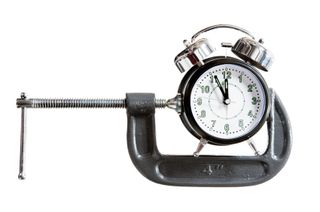It doesn’t seem to matter whether the economy is booming and work is pouring in, or the economy is down and you’re scrambling to keep clients and get everything done with a lean staff. There is a perpetual Big Squeeze for time. Nearly every business leader I coached last week was facing the same dilemma: where do you find more time when you’ve been over-committed for years and there’s nothing left of your life to squeeze more time from?
One of the executives I spoke with last week described how her organization had advised everyone to block out 30% of their time for the unexpected. Sounded like a wise plan to me. But she reported her “unexpected” workload regularly far exceeded that 30% figure. When I probed on exactly what the unexpected work looked like, it turned out that recent layoffs and reorganizations were causing even more impromptu 1:1 meetings and phone calls than usual. “It’s where I lose the most time every day,” she told me. “People drop by my office unexpectedly, my calendar is crowded with 1:1 meetings. I never know how long these things are going to take. They eat up my whole day.”
How much of your day is spent in 1:1 meetings? You might not have even considered talking with one other person a meeting, but every time someone calls you on the phone or stops by your office to “run something by you,” bring you up to speed or get your advice, it’s a little mini meeting.
Like any other meeting, a 1:1 meeting can benefit from a little structure. Most of us let our 1:1 meetings be conversations. We let them start and finish organically, with some wandering in the middle. We may or may not leave with clear result in hand. They typically take up as much time as we scheduled or as much time as we can spare.
You can add just enough structure to save precious time by asking one simple question at the beginning of any 1:1 meeting: what would we/you like to get out of this conversation? Asking this question establishes the goal of the meeting. Knowing the answer lends just enough structure to keep both of you focused and, most importantly, know when you’ve talked enough and the meeting can end. I regularly end meetings early and keep my impromptu meetings brief by taking a moment to identify the goal.
Tips on how to implement this simple technique:
- Ask this question as one of the opening lines of your meeting or early in the conversation when you find yourself wondering what the other person wants from you. For example:
- “Hi Mark, good to see you! So, what’s this meeting about? What were you hoping we’d accomplish?”
- “So Helen, it sounds like you’re concerned about how the schedule is slipping. What would you like to get out of this conversation with me? Was there specific advice or input you wanted? Or did you just want to give me a heads up?”
- “Hey Jerett, thanks for meeting with me. Before we start, I’d love to clarify a couple of things I hope we walk out of here with. I’d like to get your agreement on whether we’re ready to move forward with X, and then get your input on Y.”
- Typical goals for 1:1 meetings include
- sharing information so that one of you can go take action
- reaching an agreement or making a decision together
- creating a list of next steps
- Use the goal to keep your conversation on track. Often people provide unnecessary context, raise unrelated issues, or just lose track of what they’re talking about. You can use the goal as a reference point to keep the conversation on purpose. For example,
- “I’m not sure I need all this detail right now. If what you want is my agreement on X, let me just ask you this last question…”



